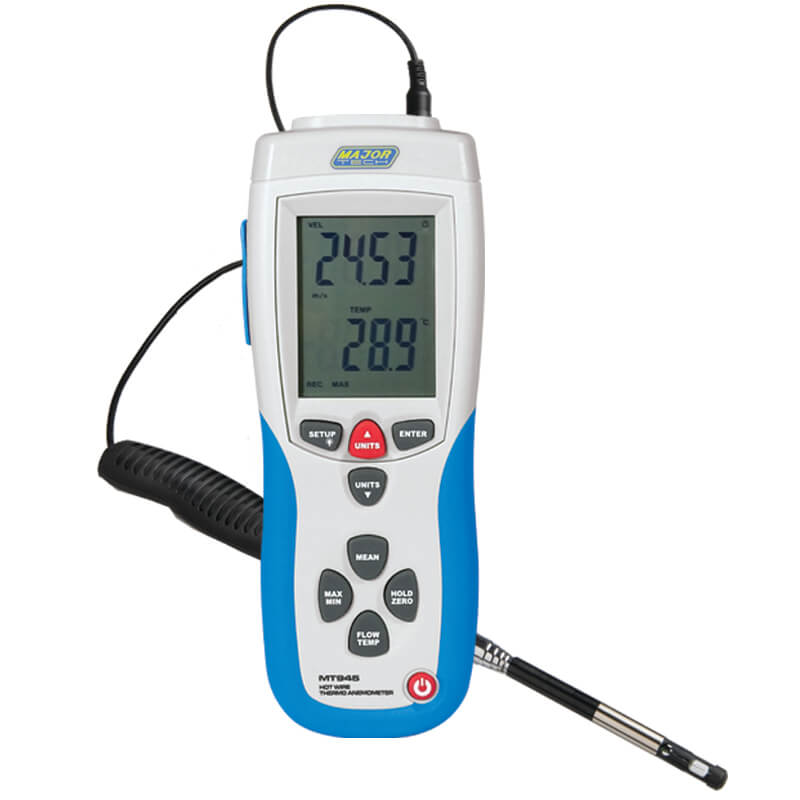The Duty of an Anemometer in Improving Safety And Security for Outdoor Activities
The Duty of an Anemometer in Improving Safety And Security for Outdoor Activities
Blog Article
All You Required to Find Out About Anemometers: How They Function, Why They Matter, and Where to Use Them
Anemometers, though often ignored in the world of scientific instruments, play an essential function in numerous areas, supplying important understandings into wind speed and air flow patterns. As we dive right into the intricacies of anemometer innovation, we will certainly reveal the internal operations of these devices, their importance, and the crucial considerations when selecting the best anemometer for certain applications.

Anemometer Fundamentals
An important tool utilized to determine wind speed and direction, the anemometer plays a crucial function in weather forecasting and various markets. An anemometer usually consists of 3 or four mugs that turn in the wind, a vane that points into the wind, and sensors to track the turnings or activities.
There are various kinds of anemometers offered, consisting of cup anemometers, vane anemometers, hot-wire anemometers, and sonic anemometers, each with its distinct features and applications. Cup anemometers are generally utilized for fundamental wind rate measurements, while vane anemometers are favored for directional measurements. Hot-wire anemometers are ideal for low airspeeds, and sonic anemometers are ideal for high-precision measurements in study and commercial setups. Understanding the essentials of anemometers is necessary for accurate wind data collection and evaluation throughout various sectors.
Principles of Anemometer Operation
Building on the fundamental understanding of anemometer basics, the principles of anemometer operation clarify the mechanics behind wind speed and direction measurements. Anemometers run on the principle of airflow affecting a sensor, triggering it to turn. Mug anemometers, for example, have three or even more mugs that catch the wind, causing them to spin much faster as the wind rate rises. The turning rate is after that transformed right into a wind rate measurement. Vane anemometers, on the other hand, use a tail or a probe that straightens itself with the wind direction, offering a measurement of wind instructions based on the orientation of the sensor. Hot-wire anemometers rely on a heated cord that cools off as wind overlooks it, with the rate of cooling figuring out the wind rate. Ultrasonic anemometers measure wind rate and instructions by assessing the time it takes for ultrasonic signals to travel between transducers. Recognizing these concepts is critical for exact and trustworthy wind dimensions in different applications.
Value of Anemometers
The significance of anemometers in meteorology and different sectors can not be overemphasized. Anemometers play an important role in determining wind rate and instructions, offering essential information for weather condition forecasting, climate research studies, ecological tracking, and aeronautics operations. Meteorologists count on anemometers to gather precise wind data, assisting them understand weather condition patterns, anticipate storms, and problem timely cautions to the general public. In markets such as construction, agriculture, renewable energy, and maritime operations, anemometers are made use of to optimize processes, make certain security, and increase efficiency. As an example, wind ranch drivers use anemometers to examine wind conditions and make the most of power production from wind useful content turbines. In the maritime sector, anemometers aid ship navigation by providing real-time wind info to captains, aiding them make educated choices to ensure risk-free voyages. On the whole, anemometers are vital tools that add significantly to security, effectiveness, and notified decision-making in meteorology and a wide variety of markets.
Applications Across Various Industries
In the sustainable power sector, anemometers play a vital function in analyzing wind conditions for wind ranch positionings, making certain ideal power manufacturing. Industries like building and mining use anemometers to keep track of wind speeds, critical for safety and security protocols, especially when functioning at heights or in open-pit mines where solid winds can pose hazards. In agriculture, anemometers assist farmers in taking care of crop spraying by supplying real-time data on wind speed to stay clear of drift.

Selecting the Right Anemometer for Your Needs
For general purposes, a mug anemometer is appropriate for determining wind rate, while a vane anemometer provides wind instructions information. Hot-wire anemometers are excellent for reduced airspeed dimensions, and ultrasonic anemometers use high precision and toughness.

Final Thought
To conclude, anemometers play an important role in gauging wind rate and direction throughout various sectors. Comprehending the concepts of anemometer procedure is important for choosing the best tool for certain needs. From weather forecasting to air travel, anemometers are vital devices for making sure and collecting precise data safety in various applications. When selecting the most ideal device for determining wind problems., it is vital to think about the value of anemometers in order to make educated choices.
There are numerous kinds of anemometers available, consisting of mug anemometers, vane anemometers, hot-wire anemometers, and sonic anemometers, each with its unique attributes and applications. Cup anemometers are frequently made use of for standard wind speed dimensions, while vane anemometers are chosen for directional measurements. Hot-wire anemometers are appropriate for reduced airspeeds, and sonic anemometers are excellent for high-precision dimensions in study and industrial settings.Structure on the fundamental understanding of anemometer essentials, the concepts of anemometer procedure clarify the mechanics behind wind speed and direction dimensions. For basic objectives, a cup anemometer is appropriate for determining wind rate, while a vane anemometer gives wind instructions information.
Report this page